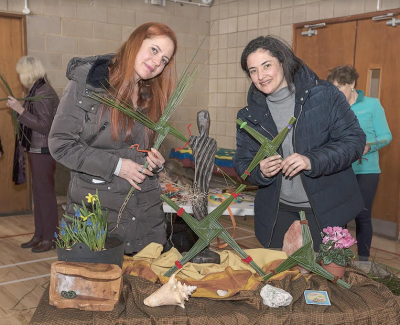 Since the last ECI newsletter, many of us have celebrated St Brigid’s Day. Sr Nellie Curtin prepared the following article for the International Little Sisters of the Assumption JPIC newsletter:
Since the last ECI newsletter, many of us have celebrated St Brigid’s Day. Sr Nellie Curtin prepared the following article for the International Little Sisters of the Assumption JPIC newsletter:
The Spirit of Brigid in Earth, Air, Fire and Water
In the folk tradition of Ireland the first day of February is the first day of Spring. It is the ancient Celtic feast of Imbolg one of the four feasts that divides the year into the four seasons. It is now known as La Fheile Bride, the feast day of Brigid, Ireland’s much loved second patron saint.
Over the centuries many customs, traditions and rituals have grown up around this feast and remnants of these can be found up to the present day. One such custom that has survived is the making of Brigid’s cross with rushes. These were placed under roofs of homes and in cattle sheds to ensure protection for humans and animals. The following year the “cross” was reduced to dust and returned to the earth to keep connected with our dependence on the earth to provide for basic needs.
Many events take place to celebrate the feast of Brigid. This year one such event took place in Tallaght, a suburb of Dublin with a population of over 80,000. The programme of the day was varied, making Brigid’s crosses and Brideoga (Little Brigids) using rushes and straw. Taking the symbolism of the four arms of the Brigid’s cross we reflected on each of the elements. There was storytelling, drumming and movement, including a dance of the four elements. There were special sessions for children. Adults chose a group representing one of the four elements. During this time in smaller groups there was an activity associated with Brigid that linked her with that particular element. And participants recalled stories that reminded them of this aspect of Brigid. At the same time they recognized the need to care for the elements in todays world and promised to put this commitment into action.
There were numerous stories told in relation to each of the elements, too many to relate in this space. Perhaps the most striking of these related to water. There are hundreds of wells around the country dedicated to Brigid. The well has its source in the earth from which it springs forth. As it says in the Life of Brigid (9th Century) she performed many miracles related to water. In one of them “she caused the spring to flow from dry land”. Today people visit these wells to pray for healing, in particular for healing of the eye. This in turn reminds us of our dependence on light, on the sun. Brigid is in very good terms with the sun. One day when minding her sheep, she got caught in a downpour and got drenched. When she returned home, she called in a sunbeam and hung her cloak on it. When it had dried she tells the sunbeam to follow its “parent” and catch up with it before sunset!
Air, Earth, Water, Fire, all so basic to life. We were aware of so many of our brothers and sisters throughout the world who do not have access to such basics as clean water, who are driven from their farms because their land is taken for mining purposes, who suffer illness because of polluted air.. In some parts of the world there is overconsumption giving rise to toxic waste with disastrous effects for seas and the earth.. We are challenged by these realities and we are called to be their protectors.
During the children’s session, they were asked to share their dreams for the future of the world and they presented a combined “mural” at a general session. One little boy suggested electricity could be powered by hampsters! A little girl wanted a world without alcohol. Another wanted everyone to have a home. They loved the stories of Brigid’s generosity to the Poor. Such as the one about her friend who brought apples to Brigid which she gave to her neighbours who needed them. Her friend said… “I brought these for you not for them”, to which she replied, “What’s mine is theirs” While these stories reminded us of Brigid’s bountifulness, the plentifulness of the earth, we were conscious of a social ecology as environmental problems affects the poorest. There is a resonance of the Cry of the Earth with the cry of the Poor.
The closing ritual involved distributing pieces of Brigid’s cloak which had been ritually cut earlier in the smaller groups. One little girl, holding her mother’s hand looked up at me and asked: “Are you God?” It struck me that children can spontaneously weave together the ecological, the social and the theological. Let us learn from them as well as from our Ancestors.
